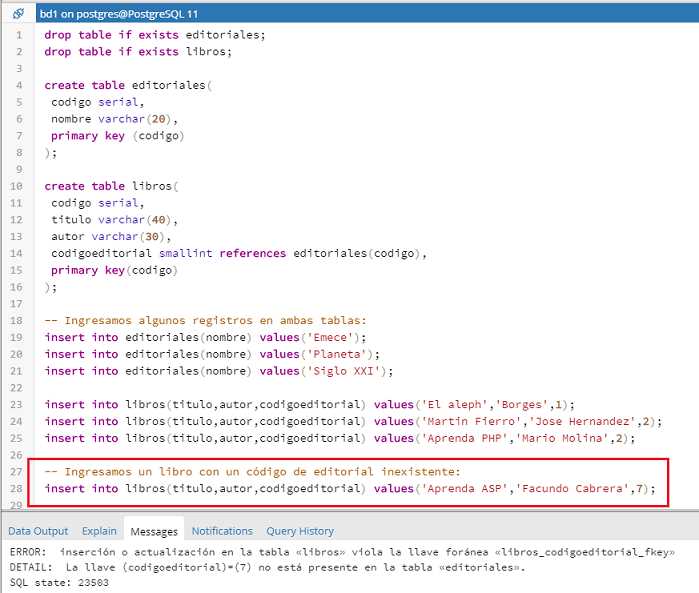

Now it can be handled entirely by Postgres! I initially encountered this problem while converting a database to use composite primary keys in preparation for migrating to Citus, and it required adding custom triggers for every single foreign key we created. REFERENCES users ON DELETE SET NULL (author_id) You can provide an explicit column list to the ON DELETE SET NULL / ON DELETE SET DEFAULT actions: The feature I added is a small syntax extension to support doing exactly this. When we delete a user, we really only want to clear the author_id column in the posts table, and we want to leave the tenant_id column untouched. When you delete a user, it will try to set both the tenant_id and author_id columns on the posts table to NULL:ĮRROR: null value in column "tenant_id" violates not-null constraintĭETAIL: Failing row contains (null, 201, null). Tenant_id int REFERENCES tenants ON DELETE CASCADE,
#POSTGRESQL FOREIGN KEY SERIAL#
This is useful for schemas that use a denormalized tenant id across multiple tables, as might be common in a multi-tenant application:ĬREATE TABLE tenants (id serial PRIMARY KEY) This post explained the FOREIGN KEY CONSTRAINT with a practical example.This release includes a feature I added to support partial foreign key updates in referential integrity triggers! The table referencing the foreign key is named the child/referenced table, while the table referenced by the foreign key is known as the parent/referenced table. A table can have zero, one, or multiple foreign keys it depends on the table’s relation with other tables. In PostgreSQL, Foreign keys are a widely used concept that allows us to link the data of one table to others. That was all the basics regarding Postgres FOREIGN KEY CONSTRAINT. The output clarifies that the emp_id is a foreign key in the dept_info table. Let’s execute the below command to understand the table’s relation more clearly: \d+ dept_info The output shows that the emp_id column is referenced by the dept_info table. Let’s run the below command to get more clarity: \d+ emp_info The dept_info table has been created successfully. Let’s create another table named dept_info that contains a foreign key emp_id: CREATE TABLE dept_info( The following example shows how a foreign key constraint can be created at the time of table creation: CREATE TABLE emp_info(Įmp_info table with four columns has been created successfully. Finally, you can use a couple of optional clauses, such as ON DELETE and ON UPDATE, to determine the referential actions.Ĭreate a Foreign Key Constraint in Postgres.In the REFERENCES clause, identify the parent/referenced table along with the foreign key columns.Next, use the FOREIGN KEY keyword followed by a set of parentheses and specify the foreign key column or group of columns within the parenthesis.The CONSTRAINT is optional if you skip it, Postgres will specify an auto-generated name. Firstly, specify the foreign key name using the CONSTRAINT keyword/clause.Let’s comprehend the above-given syntax step-by-step: The below snippet depicts the syntax of the foreign key constraint: FOREIGN KEY(col_list) Moreover, the data referential integrity is maintained between the child and parent tables with the help of the foreign key constraint. Postgres allows foreign keys to be defined using foreign key constraints. The FOREIGN KEY refers to a column/field in a table that points to the PRIMARY KEY in some other Postgres table. This write-up will cover all the basics of Postgres Foreign key constraints using practical examples. The table holding a foreign key is known as the child/referencing table, while the table which is referenced through the foreign key is named as parent/referenced table. In relational databases like PostgreSQL, Foreign keys are a widely used concept that allows us to link the data of one table to another.


 0 kommentar(er)
0 kommentar(er)
